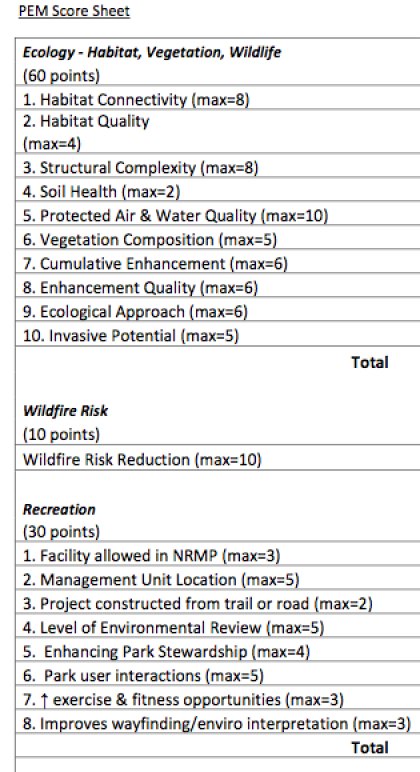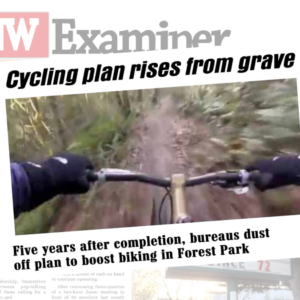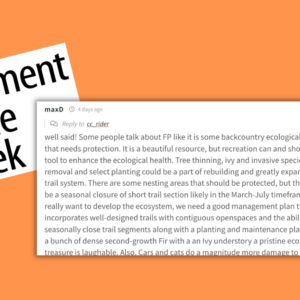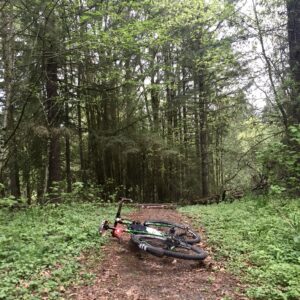
wide-reaching impact on the future of bicycle access
in Forest Park.
(Photo © J. Maus/BikePortland)
The City of Portland’s Parks & Recreation bureau recently unveiled a draft document that could act as their guide to the future of how Forest Park is used. The goal of the new Forest Park Project Evaluation Methodology (PEM) is to provide, “a systematic and consistent method to evaluate projects” in order to, “screen construction and capital projects that propose alterations to the current landscape.”
For people who care about bicycle access in the park, this is an important new document because it will help Parks staff decide if and how existing and new paths within Forest Park should accomodate bicycles. The new tool synthesizes the findings from several recent studies and surveys about Forest Park and the Parks Bureau says they plan to use it in conjunction with the existing Forest Park Natural Resource Management Plan.
At the core of the PEM tool is a scoring methodology that gives points to how projects rate on three key categories: ecology (60 points); recreation (30 points), and wildfire risk (10 points). Below is a complete breakdown of scoring:

As expected, this new PEM tool has raised the eyebrows of activists involved with the debate over bicycling in the park. And it appears both sides are concerned about it.
Marcy Houle, the dedicated Forest Park activist and author who has spent years vehemently opposing any new bicycle access in the park while lobbying local elected officials and spreading anti-bike propaganda in local papers, has already started an effort to discredit the PEM tool.
Houle wrote a letter to neighborhood groups outlining reasons why she opposes it and she’s urging others to contact Parks Commissioner Amanda Fritz with their comments. At the heart of Houle’s concerns is that the PEM tool would give Parks a way to move forward with increased bike access. “I am deeply concerned,” she wrote.
So far, we haven’t heard from the Northwest Trail Alliance about how the PEM tool might impact this ongoing debate. (UPDATE: Scroll down for comment from NWTA President Jon Pheanis.)
Frank Selker, a citizen activist who has worked to improve biking opportunities in the park, tells us he doesn’t like the PEM either. “It appears designed to create a high hurdle to any change and prevent anything from happening in the park… A wonderful project that offers great recreation and enhanced enjoyment of the public, and causes no ecological change would be rejected because it does not enhance ecology.” He says the scoring methodology in the PEM gives too much weight to ecology while giving only modest weight to user recreation. “This propagates the myth that the Natural Resources Management Plan is all about ecology, which it is not.”
He also faults the PEM for making too much of the scoring method subjective. “It gives a false impression of objectivity to what is likely to continue to be a political and neighbor-dominated issue.”
Seems like both sides of this debate have reasons to fear the PEM tool. Does that mean it might actually work? Download a copy of the draft PEM (PDF) for yourself.
Keep in mind, this is a draft tool and the City is asking for your feedback on how to make it better. If you’d like to learn more and weigh in with your thoughts, Parks will host a meeting tonight (8/5) at the Hoyt Arboretum (4000 SW Fairview Blvd) from 6:30 to 8:00 pm. If you can’t make that meeting, please send in your comments to Commissioner Fritz at amanda.fritz@portlandoregon.gov or use the online comment form. The City will be accepting comments on the PEM until August 19th.
UPDATE, 2:40 pm 8/5:
Here’s what Jon Pheanis, president of the Northwest Trail Alliance, thinks about the PEM:
“Our main question related to the draft PEM is simply whether any new trails or trail improvements would ever be possible. Clearly the primary management goal of the park is to protect and improve ecological health and wildlife habitat. But do the criteria effectively end the chance of any new or improved trails? According to the city, the majority of studies done to date all indicate that the majority of Forest Park users are white, middle-aged, from Multnomah County and have a higher average income. Why doesn’t the PEM encourage more diverse users? Part of the bureau’s mission is to provide parks for all. Not only would we like this issue addressed, but we would like to see the city proactively try to change the statistics for park use. We feel trails are one way to make this happen, but right now, not possible given the draft scoring system.
We are also disappointed that the draft does not forward any of the hard work and recommendations brought forth from the single track advisory committee; a diverse group of stakeholders who have demonstrated how divergent interests can work together and come up with some reasonable, cost-effective and publicly-supported recommendations. The PEM does not encourage collaboration, cost effectiveness or projects that serve multiple interests and goals.
Of course there are procedural questions that the draft doesn’t address, such as: can the proposer still submit a land use application? If so, what is the review process and what, if anything, can the public do if they feel their project was evaluated unfairly?
Nevertheless, we hope for a great turnout tonight with a chance to hear from all sides. As a first draft, we feel optimistic that this initial draft will serve as a catalyst for discussion for a better managed Forest Park.”






Thanks for reading.
BikePortland has served this community with independent community journalism since 2005. We rely on subscriptions from readers like you to survive. Your financial support is vital in keeping this valuable resource alive and well.
Please subscribe today to strengthen and expand our work.
Let the comments begin…. weee!
The recently released PEM is a draft, which is a good thing because it’s a fairly bad document from a range of perspectives, especially in relation to recreation and any future trails development/improvement.
Tonight’s meeting is an opportunity for all stakeholders to voice their questions and concerns. Written comments are then due by August 19th but I am hoping the city will be forced to extend that deadline…if not abandon this draft tool altogether.
Just as Frank Selker indicated, try reading the document and try scoring virtually any trail development project you can imagine (including the most ecologically benign) and see if your theoretical project could EVER win approval under these criteria. Not.
So the city’s focus will now shift from “getting things done in forest park”, to “getting things done with crafting their rough draft internal project ranking and approval document for possible future enhancements for Forest Park”?
If these criteria had been in place during any of the previous trail-building periods, then such trails as Wildwood and Cannon trails wouldn’t exist. This is probably just as Marcy Houle would have it: trails for hikers are fine for the environment, but trails for bikes are an environmental apocalypse. It’s much like the idea of settlers telling the latest immigrants that the land is all full- no more room for anyone else. The fact is, every trail built is a new opportunity for erosion or introduction of invasive species, whether from boots or tires. Houle’s not out there trying to solve the problem of unleashed dogs or erosion from boot tracks. . . it’s the mountain bikes that rouse her animus.
We really don’t need any new trails. The existing trails would work fine if we shared them, for instance wednesday and sunday some of the trails could be bicycle only. The problem is that folks like Marcy aren’t willing to share.
mmmmm, can’t say I agree with this. There aren’t that many single track trails in the park and the few there are, like Wildwood, have countless blind turns which are a bad idea for shared, bidirectional trails.
“for instance wednesday and sunday some of the trails could be bicycle only.”
I don’t think that giving up a trail or two once or twice a week is asking too much.
If the extremists on both sides are upset with it, that’s a good sign that it strikes a somewhat fair balance. Looks good to me.
I appreciate the spirit of your comment but keep in mind that satisfying the extremists should never be a criteria for evaluation.
Chris I,
In this situation, I really don’t think that those advocating for improved bike access merit the label “extremist.” Based on actions and words, I only see an extremist in one side of this debate. I’d love to hear your evidence for calling people like Selker or Pheanis “extremists.”
…thank you.
“…At the heart of Houle’s concerns is that the PEM tool would give Parks a way to move forward with increased bike access. …” maus/bikeportland
The phrase “increased bike access” apparently meaning using Forest Park for mountain biking.
A majority of Portland residents would likely be uneasy with, and reject any means devised to make use of Forest Park for mountain biking.
Thanks once again for your imaginary insights regarding the wishes of the majority of Portland residents.
That have been refuted by polling of actual parks users!
Nope. It doesn’t mean that. People who are against improved bike access in the park want it to mean that because it conjures up images of daredevil riders with full-face helmets and full-suspension bikes running down innocent bystanders simply for a thrill. However, that image is nothing but stereotyping and it doesn’t represent the responsible people that want to ride in the park. So… It does mean increased/improved access for bicycling. This is not about mountain biking specifically, this is about allowing people using whatever bikes they choose to ride in the park and enjoy different types of roads/trail environments.
Nope. I disagree. If you presented the idea in an objective way — and not the fabricated “safety crisis” Ms. Houle wants you to believe in — I guarantee a majority of Portlanders would support creative solutions to improving bicycling opportunties in Forest Park.
“…The phrase “increased bike access” apparently meaning using Forest Park for mountain biking. …” wsbob
“…Nope. It doesn’t mean that. …” maus/bikeportland
If you don’t intend your phrase”increased bike access”, to mean use of Forest Park for mountain biking, perhaps you’d better begin being a little more clear about exactly what you do intend those words to mean.
There’s plenty of road miles within the park that biking is officially allowed on. The main issue here, is the use, sought after by mountain bike enthusiasts, of Forest Park’s narrow width trail for biking, a type of trail most people would likely use some form of mountain bike for. It stands to reason that on that that type trail, as they do anywhere, people will tend to ride as mildly or aggressively as they personally see fit.
“…This is not about mountain biking specifically, this is about allowing people using whatever bikes they choose to ride in the park and enjoy different types of roads/trail environments. …” maus/bikeportland
Perhaps not mountain biking specifically, but mountain biking primarily.
“…A majority of Portland residents would likely be uneasy with, and reject any means devised to make use of Forest Park for mountain biking.” wsbob
“…Nope. I disagree. If you presented the idea in an objective way — and not the fabricated “safety crisis” Ms. Houle wants you to believe in — I guarantee a majority of Portlanders would support creative solutions to improving bicycling opportunties in Forest Park.” maus/bikeportland
Put it to a vote of the people. You and mountain bike advocates: make your case and put your desire to use Forest Park for mountain biking, before Portland’s electorate. Be sure you make it very clear that what you’re after is not simply “…improving bicycling opportunities…”, but in particular: officially establishing narrow width, single width dirt trail in the park for whatever type of biking, people bringing a bike to the park to ride on that type of trail, choose to do.
Mountain biking may have been accepted in other parts of the U.S., but I’m not so sure a majority of Portland residents would give it a thumbs up for Forest Park. But you can try. Forest Park, as many, many Portland residents know, is unique as nature parks go…expansive, a long standing history, conceived of and assembled as an urban adjacent wilderness. Except for the roads in the park: wonderfully free of all vehicle traffic, including bicycles.
wsbob,
You and I clearly see this issue differently. That’s fine. I remain convinced however, that it would be easy and possible to vastly improve bicycling opportunities in Forest Park while maintaining its current standing as an awesome and safe and pleasant urban forest/park (it is not a wilderness by any stretch).
One thing that I think is interesting about this debate is that there is absolutely zero data or proof that more bicycling in the park is inherently problematic (either from a user safety or environmental impact point of view). However, there is proof that invasive plants are a major problem, that off-leash dogs are a major problem, that goat trails created by the thousands of runners and hikers are a problem, and so on.
If Forest Park is to be managed like a wilderness, we would need to regulate it much more for all users — that would mean capping access by hikers/runners, prohibiting running marathons and other events that currently happen there, charging for all the auto parking that happens at the trailheads in order to pay for maintenance, and so forth. However, since everyone is fixated on villifying bicycling, we somehow never talk about all those other very important issues.
Thanks.
Opposition to single track cycling does not mean an indifference to off-leash dogs or invasive plants. Two chronic problems have to be dealt with differently from a newly introduced use which would require construction. Surely you can see that the approach would be different?
WSBOB:
Perhaps the most revealing statement in your most recent post is where you attempt to summarize: “The main issue here, is the use, sought after by mountain bike enthusiasts, of Forest Park’s narrow width trail for biking…” Actually, the main issue here is the false distinction you are constantly asserting and striving to establish between mountain bikers and other members of the park’s constituency. Access to some portion of Forest Park’s trails is being sought after by Forest Park enthusiasts who would like to be able to visit and experience the park by bicycle – among other means. If you could just get “us vs. them” out of your head for a few minutes, you might begin to see that there is a single community unified in its desire to see Forest Park protected and enjoyed in perpetuity.
“Why not put it to a vote?” you say. “Let the people decide.” Well, that would be – to my knowledge – one of the first (if not the only) times that a measure like that appeared on a ballot for local popular vote. And the reasons are fairly simple. First, we pay professional land managers – often guided in part by the advisory work of designated citizens groups – to make, hopefully, fact-based decisions regarding a range of aspects of land and recreational trails management. There is a wealth of information and experience regarding shared use trails based on thousands of miles of recreational trails use that takes place everyday around the world. Second, opponents of bicycle use have invested so much effort in spreading paranoia, alarm and obfuscation surrounding bicycles that it’s almost impossible to imagine an informed voter showing up at the ballot. While poorly informed voters may be the hallmark of American democracy, your apparent desire to rely on them to advance your cause does not necessarily serve the public good.
Lastly, you assert that shared use advocates are promoting some kind of lawless chaos in the park: “whatever type of biking [mountain bikers] choose to do.” Really, do people driving cars on our roads and freeways do whatever kind of driving they choose to do? Well, I suppose some do. But for the most part we have a system and a culture that successfully constrains behavior into a rather narrow part of the spectrum. Why aren’t we working together to make sure that we design and build a local trails system and trails culture that encourages exactly what the community, the Forest Park Natural Resources Management Plan and all the subsequent/supporting documents agree should be the goals of the park? That’s a rhetorical question because the answer is clear: some people are too busy, as Jonathan just said, vilifying those members of the community who would like to sometimes ride their bicycles on at least some portion of the Forest Park trails system.
I will once again inform Washington County residents, that I promise never to blog comment concerning issues related to cycling in their county….if they will politely refrain from trying to sway opinions in mine.
I will keep doing this with regards to” Mr.wsbob”, as long as he keeps it up…sorry Mr. Maus.
I don’t think wsbob’s comments should be discounted just because he resides elsewhere. I think they should be discounted because they are often baseless or incorrect.
Then in fact, there are TWO solid reasons.. 🙂 I am not as kind as yourself.
Are existing trails and projects to be evaluated using the PEM as well or only new ones? If only new ones, the high hurdle of the PEM gives an implicit bias to the types of uses and changes approved by past choice methodologies. Given that 60% of the weight is given to ecology and that pretty much every trail has a (small) negative impact on ecology, I would expect that most of the existing trails in Forest Park would not have been constructed if the PEM had been used.
However, if the PEM ends up being put into effect, the NWTA could use it to their advantage. The offer of volunteer MTBer labor pulling ivy and other invasive species in a wide swathe around prospective mountain bike trails could cause a combined trail / invasive species removal project to be rated very highly. Improving habitat in a large area could outweigh the localized negative effect of a trail.
20 bucks sez’ that projects by the likes of the NWTA and other cycling groups would meet, or exceed the action paid by those opposed to bicycle access expansion in the FP area. Especially in regards to maintenance and management of the trail systems.
Your observation is probably correct. The PEM tool as currently written would likely preclude all future (and past) trails development in FP.
Has there been any talk of updating/revising the 1995 Forest Park Plan? That document currently outlines the procedures required to manage the park, the vision for the future of the park at that time, and the type of trails that each type of user would be able to use based upon their mode of transportation, whether it is by foot, tire or hoof.
It seems to me the 1995 Plan is, and was, a good start, but it needs to be updated to reflect the type of experience each user would prefer. This entire fiasco started in 1988, it’s now 2013, and you’d think by now the Plan would be revisited, revised by a consensus of all interested user groups, and eventually approved by the City as it was before.
LONG LIVE PUMP!
Perhaps they were thinking (hoping) that mountain biking just wouldn’t catch on…….
Any update on how the meeting went? I couldn’t make it over last night.
The meeting went quite smoothly. It was well attended (about 40 people) and well presented by Park & Rec staff. Commissioner Fritz was there listening, greeting and inviting involvement as well.
Staff presented a good but brief overview of FP history and planning as well as a description of how and why the PEM tool came into being. It was really nothing more than what’s already contained in the text of the PEM document. Public comments were necessarily limited by the nature of the event. The primary focus was on the PEM tool and its potential use rather than on specific issues of trail use or conflict. Nevertheless, people on both sides did their best to insert their particular bias. Anti-recreation and anti-bicycle sentiments – muddled with concerns about long-term conservation – were common, but staff were not entertaining any kind of debate.
I think the crowd was the usual cast of characters, including a healthy mix of venerable old-timers with a range of concerns or axes to grind – perhaps all sincere in their conservation goals but often uninformed or just plainly selfish with regard to insulating their own favored form of recreation. Some speakers made the typical unqualified assertions about environmental impacts and user safety but the event and venue were not really suitable for staff or others to point out that those concerns are largely baseless. As usual, many of the public comments were as if Forest Park exists in a strange bubble and that the experience of managing thousands and thousands of miles of recreational trails elsewhere in the country and the world could not possibly have any relevance to decision making in Forest Park.
In sum, almost everybody had problems with the PEM tool, mostly focused on the scoring system that seemed either arbitrary or weighted too much/not enough on conservation or recreation depending on your perspective. In that sense, it perpetuates the false dichotomy that is at the heart of so much conflict. My read is that it is weighted far too heavily – and technically incorrectly – on ecology, while it simultaneously misses some ecological concerns as well.
The real opportunity for feedback will be in written form by the Aug 19th deadline. Parks & Rec is going to want to see very specific suggestions for fixing and improving the details of the PEM tool.
In the Oregonian from August 6th, there is this article: http://www.oregonlive.com/portland/index.ssf/2013/08/forest_park_trail_marathon_onl.html
“Forest Park Trail Marathon online registration wraps in one week”
which states: “The event benefits Forest Park Conservancy, which maintains the forest and its trails. To date the marathon has raised $21,270, according to the organization.
If registration isn’t full to its 350-person capacity by the day of the race, teams, families, groups and individuals may register the day-of, says Lisa Hillerns, with the conservancy.
For information about registration, contact Hillerns at lisa@forestparkconservancy.org or 503-223-5449, ext. 101.”
Note the number of runners: 350. What’s wrong with that number? Portland Parks has rule against allowing an event that brings more than 150 people into Forest Park at one time. Why are they allowing this running event, with 350 people, to be permitted? Aren’t they concerned that this large number of people will scare the wildlife? What does WSBOB and Audubon think?
How do I know this? Years ago I asked permission to add a Forest Park route to the 10th Anniversary of the Bridge Pedal, with the support of the guy (sorry, his name escapes me) who runs the Bridge Pedal. The goal of PUMP was to educate the select riders who would be allowed to add this route to their Bridge Pedal ride about the rules of the Park for bicyclists. The route would divert them from NW Vaughan, up Thurman, along Leif Erickson, and down Saltzman. We contacted the Parks Department, and they notified us of this rule. That meant NO to our idea.
How did they, Forest Park Conservancy, get permission?